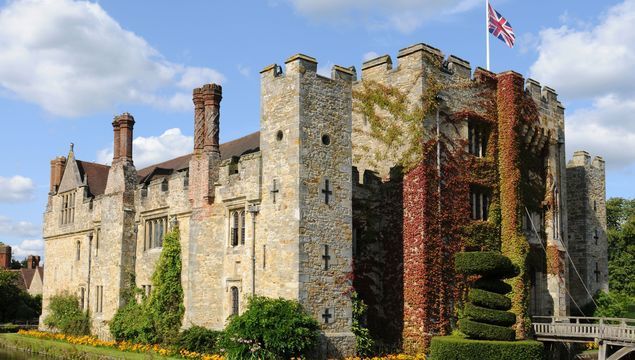
Hever Castle was the home of Anne Boleyn, the second wife of King Henry VIII who was beheaded.Getty
The pastoral garden county of Kent houses an extraordinary collection of historic fortresses, from Canterbury Cathedral to Battle Abbey and Dover Castle there's something for every Anglophile.
Balustrades and portcullises, sally ports, keeps, and moats: our images of English castles conjure up medieval knights in full armor. In fact, the castle had life for centuries before and after such a scene. From a staging ground for Roman legions to an intelligence bunker in World War II, the castles of Kent have been a dominating institution of social and military history.
It should come as no surprise that the pastoral garden county of Kent houses such an extraordinary collection of historic fortresses. After all, along with the narrowest point of the English Channel, Kent is the gateway to Europe and the front line of defense. Let’s go exploring two millennia of castle life and building. Here is a great easy road trip with a theme. Along the way, there are rural lanes, coast houses, assorted colorful country pubs and scenic vistas galore.
Leeds Castle & Hever Castle
Heading to Kent from London or the airports, steer via the M25 east to the M20. A grand place to begin our castle exploration is beautiful Leeds Castle, one of the most historic and picturesque castles in England. Say farewell to the motorway at junction 8 and follow the signs. Set in a majestic moat surrounded by 500 acres of parkland and gardens, Leeds was built in the early 1100s and looks much the same. In royal hands for centuries, Henry VIII refurbished the castle as a home for his first queen, Catherine of Aragon. Later, the castle belonged to the Culpepper/Fairfax family, from whence sprung First Families of Virginia.
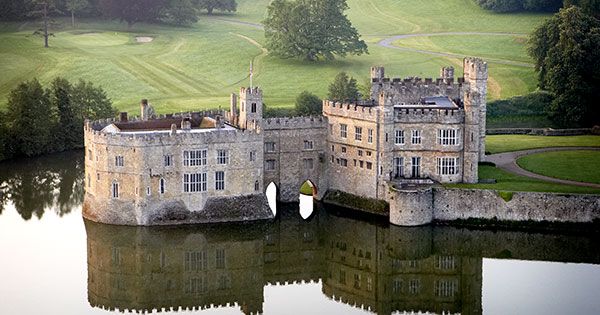
Leeds Castle (Image: Leeds Castle)
After your visit, turn west a few miles on the A26 through Tonbridge to Edenbridge, for a visit to homey Hever Castle. The moated Tudor castle was where Henry VIII courted second wife Ann Boleyn. Acclaimed for its topiary and Italianate gardens, Hever was sympathetically restored by William Waldorf Astor early last century and has a great exhibit on the Boleyns and the Tudor court.
The Georgian spa town of Royal Tunbridge Wells makes a nice overnight destination. You might catch Tonbridge Castle on the way, but do save time to walk the 18th-century Pantiles at Tunbridge Wells, where the famous Beau Nash served as master of ceremonies to the social elite of the day.
Bodiam Castle, Battle Abbey and the South Coast
Take a leisurely start to the morning, and join the A21 south roughly 20 miles drive to Bodiam Castle. Built-in 1385, Bodiam was the last great moated castle completed in England - before gunpowder and cannon made castles obsolete as a military sanctuary. Today flawlessly maintained by the National Trust, Bodiam is a picture-perfect ruins often used as a film set.
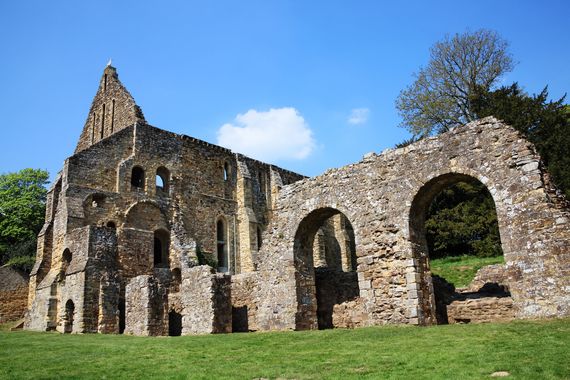
A few miles south in Battle, Battle Abbey is not a castle but looks like one. On the field of the Battle of Hastings, where William of Normandy became the Conqueror in 1066, William had the abbey built-in thanks to God for his victory. The abbey church altar marks the spot where King Harold died. It’s a great visit and a pretty village.
Hastings itself lies half a dozen miles south on the coast. The crumbling remains of Norman Hastings Castle sit on the cliff top towering over the faded seaside resort town below. Or first, detour west about 10 miles to Pevensey Castle. In the care of English Heritage, and always open, its curtain walls were built by the Romans in the third century (and still stand). The Normans reoccupied it in 1066 and added a keep and bailey. Though long a ruin, the castle was refortified and garrisoned during World War II. Hastings has a full range of accommodation, or perhaps follow the A259 east to pretty Rye for your overnight.
Chilham Castle an Canterbury Cathedral
This morning’s drive crosses archetypal Garden of England landscapes, through Darling Buds of May countryside. From Hastings or Rye, make for the A28 northeast. The pretty market town of Tenterden makes a lovely morning stop for coffee - or for a ride on the old steam Kent & East Sussex Railway. The A28 leads to the historic cathedral city of Canterbury. North of Ashford, you might stop in tidy Chilham village for a visit to Chilham Castle. Though of medieval origins, the castle was refurbished in 2002 as a private residence. It is open on a limited basis to the public. Even if the castle gates are locked, the flower-bedecked village square makes a picture-worthy setting for lunch or tea.
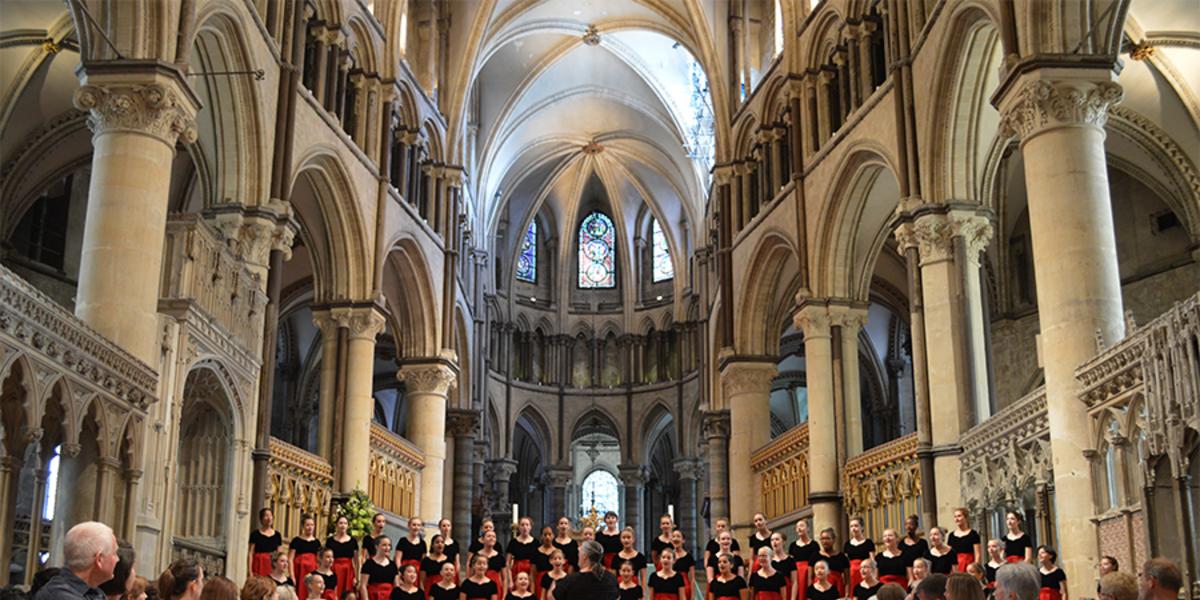
Canterbury Castle (Image: Canterbury Cathedral)
Do continue on to arrive in Canterbury with an afternoon to explore this magnificent, visitor-friendly city. The centerpiece, of course, is medieval Canterbury Cathedral, mother church of the worldwide Anglican communion. The ruins of St. Augustine’s Abbey, Greyfriars, an old-world pedestrianized shopping and dining precinct, and an assortment of Chaucer and Dickens attractions also bring visitors from around the world. Canterbury has a full range of visitor lodgings and makes a great place to base a two-night stay.
Dover Straits, Castle and White Cliffs
If time permits do add in a short ride to the port of Dover - and imposing Dover Castle. Guardian of the Straits, Dover Castle is the second largest in Britain (after Windsor). Its medieval strength and purpose are profiled by the building of King Henry II. The historic castle, however, is as fascinating for “Hellfire Corner,” where the evacuation of Dunkirk was directed and a World War II field hospital was carved into the castle’s famous limestone cliffs.
You might return this afternoon to continue exploring or shopping in Canterbury, or drive north along the white-cliff coast to Walmer Castle, built by Henry VIII and official residence of the Lord Warden of the Cinque Ports. Deal Castle, a coastal fort originally built by Henry III is just up the road. It’s an easy return to Canterbury on the A257.
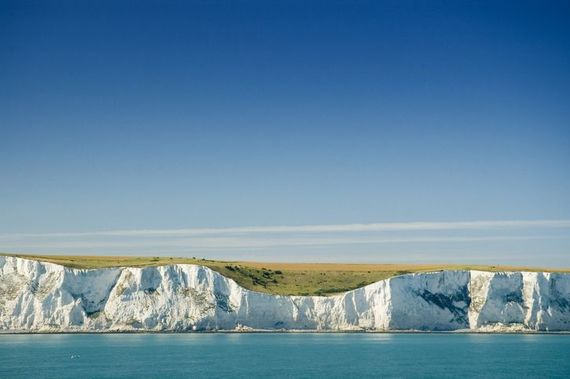
Back to the River Medway and Rochester Castle
Turning back toward London, the M2 bears the brunt of the traffic and the lorries. Running roughly parallel, the A2 is more fun, following the route of Chaucer’s 14th-century pilgrims. The Norman fortress of Rochester Castle makes a dramatic finale to our theme, overlooking the River Medway. The imposing castle, across the green from Rochester Cathedral has the tallest, most complete medieval keep in England. If you’ve more days to travel, perhaps turn north on the M25 across Deptford Crossing to East Anglia and Constable Country or Norwich.
* Originally published in Apr 2016.





Comments